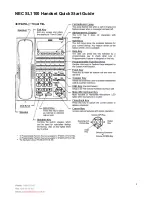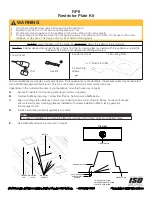
49
Mounting and Operating Instructions CEAG Battery Cabinets
40071860035 (N) March 2016 www.ceag.de
5 Transport, Packaging and Storage
•
Avoid storing unpacked cells / monoblocs on sharp-
edged supports.
•
It is recommended to have the same storage conditions
within a batch, pallet or room.
5.10 Storage
Keep packages closed up to mounting and observe the exter-
nal marked arrangement and storage notes. Store packages
under the following conditions:
• Not to be stored outside
• Keep dry and dust-free
In the interests of users the time of storage should be as
short as possible.
Fig. 1: Sprinter – remaining capacity in % of C10 versus time
of storage with different temperatures
Fig. 2: Marathon – remaining capacity in % of C10 versus
time of storage with different temperatures
5.11 Time of Storage
The maximum time of storage is 12 months with tempe-
ratures of 20°C. Higher temperatures cause a higher self
- discharge and shorten the intervals between the chargings.
5.12 Measures during Storage
Appropriate inventory turnover based on FIFO - method
(“First In- First Out”) will result in a higher operating quality
of the products.
If the battery casings must be cleaned (prior to their installa-
tion) never use solvents or abrasives. Use water (wetcloth)
without additives.
For extended storage periods it is recommended to check
the „open-circuit“ voltage at the following intervals:
• storage at 20°C: after a storage period of 6 months, then
every 3 months afterwards.
• storage at 30°C: after a storage period of 4 months, then
every 2 months afterwards.
When measured „open circuit“ voltage is < 2,11 V/C, battery
has to be recharged.
Trickle charging*) should be considered necessary when the
measured open circuit voltage (OCV) is < 2,11 V/C.
*)Trickle charging means continuous charge at a low rate,
approximately equivalent to the internal losses of the battery
and suitable to maintain the battery in a fully charged state.
It can be carried out either by IU-charging (=float charging) or
I-charging (constant charging) with limited current.
Trickle charging mode durging storage
Constant charging (IU-charging)
Tempe-
rature
Max.
voltage per
cell
Min.
voltage
per cell
Max.
current
Charging
time at max.
voltage
20 °C
2,38 V
2,27 V
0,2 C
10
24 h
25 °C
2,35 V
2,25 V
0,2 C
10
24 h
30 °C
2,32 V
2,22 V
0,2 C
10
24 h
chart 1: Value for constant voltage charging (Marathon L)
Constant charging (IU-charging)
Temper-
ature
Max.
voltage
per cell
Min.
voltage
per cell
Max.
current
Charging
time at max.
voltage
20 °C
2,40 V
2,29 V
0,2 C
10
24 h
25 °C
2,37 V
2,27 V
0,2 C
10
24 h
30 °C
2,35 V
2,25 V
0,2 C
10
24 h
chart 2: Value for constant voltage charging (Sprinter)
Depending on the chargers the charging time shall be exten-
ded by 24 hours for every 0,04V less than the maximum volta-
ge, in which the „minimum voltage“ is still the lower limit.
For temperatures < 15 °C it is recommended to charge the
battery 20 hours.
Average remaining capacity in % of C10
Average remaining capacity in % of C10
Time of storage in months
Time of storage in months












































